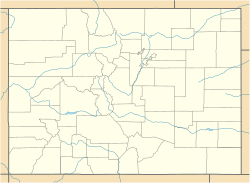Fort Davy Crockett, also called Fort Misery, was a trading post of the late 1830s and early 1840s. The site is located within Browns Park National Wildlife Refuge in Moffat County, Colorado.[1][2] Unlike most trading posts within the confines of the current state of Colorado, Fort Davy Crockett was located west of the Rocky Mountains in what is now northwestern Colorado.[1][2][a]
White-Indian Contact Site also known as Fort Davy Crockett | |
| Location | Browns Park National Wildlife Refuge, Moffat County, Colorado |
|---|---|
| Coordinates | 40°47′10.25″N 108°53′39.83″W / 40.7861806°N 108.8943972°W |
| NRHP reference No. | 77001561 |
| Added to NRHP | March 8, 1977 |
A site listed on the National Register of Historic Places as White-Indian Contact Site, is apparently this Fort Davy Crockett. It is historically significant due to the contact of European Americans and Native Americans when the trading post was established in the 1830s. Brown's Hole continued to be a rendezvous point for fur trappers and traders when the fort was abandoned.[4]
Fort and trading post
editThe trading post was established between 1832 and 1837 by Phillip Thompson, Prewitt Sinclair, and William Craig. Made of adobe and cottonwood,[3][5] it was described as a "hollow square of one story cabins, with roofs and floors of mud... Around these were found conical skin lodges of the squaws of the white trappers, who were away on their fall hunt. Here also were the lodges of Mr. Robinson, a trader."[3][6] Due to "deplorable living conditions",[3] some trappers called it Fort Misery[1][2] or Fort de Misère.[5] Kit Carson and other mountain men stayed at the trading post,[5] which served many purposes. It was a place to trade furs for money or supplies, a social center, a tavern, and a lodge.[7]
| External image | |
|---|---|
| Fort Davy Crockett Historical marker |
By the winter of 1839, however, inhabitants were starving and resorted to purchasing dogs from Native Americans for meat. This was verified following an archaeological survey that found dog bones at the site. After a reduced demand for beaver fur, the trading post was abandoned by 1844. A historical marker is located at Lodore School, or Lodore Hall, in the wildlife refuge.[3]
Notes
edit- ^ It is described as being on the Green River and Vermillion Creek in the Brown's Hole area.[1][2] It is also described as being off of Highway 318 and about one mile northwest of Ladore School, also known as Ladore Hall (40.7802399,-108.8950827). Green River has changed its course over the years, making finding the exact location difficult.[3]
References
edit- ^ a b c d Jolie Anderson Gallagher (April 2, 2013). Colorado Forts: Historic Outposts on the Wild Frontier. Arcadia Publishing Incorporated. p. PT9. ISBN 978-1-61423-903-1.
- ^ a b c d Carl Abbott (May 15, 2013). Colorado: A History of the Centennial State, Fifth Edition. University Press of Colorado. p. PT603. ISBN 978-1-4571-8125-2.
- ^ a b c d e Jessen, Kenneth (October 31, 2016). "Fort Davy Crockett also got the name Fort Misery". Reporter-Herald. Loveland, Colorado. Retrieved June 8, 2018.
- ^ "White-Indian Contact Site". History Colorado.
- ^ a b c Roland G. Robertson (September 1, 2012). Competitive Struggle: America's Western Fur Trading Posts, 1764-1865. University of Nebraska Press. p. 101. ISBN 978-0-87004-571-4.
- ^ Edwin Legrand Sabin (1935). Kit Carson Days, 1809-1868: Adventures in the Path of Empire. U of Nebraska Press. p. 278. ISBN 0-8032-9237-6.
- ^ Stephen B. Shaffer (July 11, 2017). Utah's Hidden Treasure: Outlaw Loot in Every County. Cedar Fort. p. PT34. ISBN 978-1-4621-2809-9.
Further reading
edit- Barton, John D.; Utah History Encyclopedia staff (1994). "Fort Davy Crockett". Utah History Encyclopedia. University of Utah Press. ISBN 978-0-87480-425-6. Archived from the original on November 3, 2022. Retrieved April 24, 2024.

